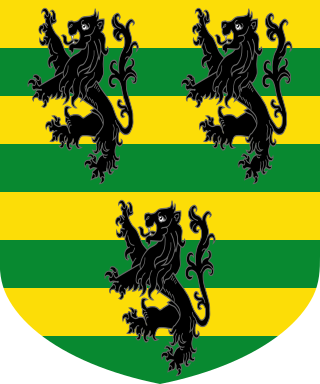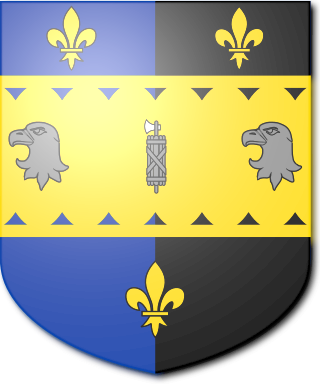Related Research Articles
The Stronge baronetcy of Tynan was conferred in the Baronetage of the United Kingdom on 22 June 1803. The family were northern Irish landowners of Tynan Abbey, County Armagh, also possessing the residence of Lizard Manor, Aghadowey, County Londonderry.

The Macara Baronetcy, of Ardmore in St Anne-on-the-Sea in the County of Lancaster, was a title in the Baronetage of the United Kingdom. It was created in 1911 for the Lancashire cotton-spinner, Charles Macara. The title became extinct upon the death of the fourth Baronet in Dudley in 1986.

The Sitwell Baronetcy, of Renishaw in the County of Derby, is a title in the Baronetage of the United Kingdom. It was created on 3 October 1808 for Sitwell Sitwell, Member of Parliament for West Looe. The Sitwell family had been ironmasters and landowners in Eckington, Derbyshire, for many centuries.

The Ainsworth Baronetcy, of Ardnanaiseig in the County of Argyll, is a title in the Baronetage of the United Kingdom. It was created on 12 January 1917 for the industrialist, banker and Liberal politician John Ainsworth.

The Bagge Baronetcy, of Stradsett Hall in the County of Norfolk, is a title in the Baronetage of the United Kingdom. It was created on 13 April 1867 for William Bagge, Conservative Member of Parliament for West Norfolk. The sixth Baronet was Chairman of the West Norfolk District Council between 1976 and 1977.

The Whitehead Baronetcy, of Highfield House in Catford Bridge in the County of Kent, is a title in the Baronetage of the United Kingdom. It was created on 26 November 1889 for James Whitehead, Lord Mayor of London between 1888 and 1889 and later member of parliament for Leicester. His younger son, the third baronet, was also a Member of Parliament.

The Wigram Baronetcy, of Walthamstow House in the County of Essex, is a title in the Baronetage of the United Kingdom. It was created on 30 October 1805 for Robert Wigram, a successful shipbuilding merchant and politician, representing Fowey and Wexford Borough in the House of Commons. The second Baronet also represented Wexford Borough in Parliament. He assumed in 1832 by Royal licence the surname of Fitzwygram. The fourth Baronet was a Lieutenant-General in the army and sat as a Conservative Member of Parliament for South Hampshire and Fareham.

There have been two baronetcies created for the Guise family, one in the Baronetage of England and one in the Baronetage of Great Britain. The latter creation is extant as of 2014.
There have been four baronetcies created for persons with the surname Bell, all in the Baronetage of the United Kingdom. One creation is extant as of 2007.

The Synge Baronetcy, of Kiltrough in the County of Meath, is a title in the Baronetage of the United Kingdom. It was created on 12 August 1801 for Robert Synge. The third Baronet served as High Sheriff of County Cork in 1844. The family surname is pronounced "Sing". As of 28 February 2014 the present Baronet has not successfully proven his succession and is therefore not on the Official Roll of the Baronetage, with the baronetcy considered dormant since 2011.

The Smith, later Smith-Marriott Baronetcy, of Sydling St Nicholas in the County of Dorset, is a title in the Baronetage of Great Britain. It was created on 1 June 1774 for John Smith, High Sheriff of Dorset in 1772. The second Baronet married Elizabeth Anne, daughter of Reverend James Marriott. The fourth Baronet assumed by Royal sign-manual the additional surname of Marriott. The fifth Baronet was High Sheriff of Dorset in 1873.

The Smith, later Hamilton-Spencer-Smith, later Spencer-Smith Baronetcy, of Tring Park in the County of Hertford, is a title in the Baronetage of the United Kingdom. It was created on 11 June 1804 for Drummond Smith, with remainder to the heirs male of his niece Augusta, wife of Charles Smith, MP, of Suttons, Essex. The latter was a descendant of Robert Smith, of Ilminster, from whom the Smith-Marriott baronets are also descended. The fifth Baronet, was a member of the Military Inter-Allied Commission of Control from 1920 to 1924. The sixth Baronet discontinued the use of the surname of Hamilton.

The Dalrymple-Horn-Elphinstonebaronetcy, of Horn and of Logie Elphinstone in the County of Aberdeen, is a dormant title in the Baronetage of the United Kingdom. It was created on 16 January 1828 for Robert Dalrymple-Horn-Elphinstone. He was the grandson of Hew Elphinstone, second son of Hew Dalrymple, Lord North Berwick, third son of James Dalrymple, 1st Viscount of Stair. The second Baronet sat as Member of Parliament for Portsmouth. The fifth Baronet assumed the surname of Elphinstone-Dalrymple. The title became either extinct or dormant on the death of the seventh Baronet in 1956.

Sir Andrew Agnew, 8th Baronet DL was a Scottish politician and baronet.
The Jervoise, later Clarke-Jervoise Baronetcy, of Idsworth in the County of Southampton, was a title in the Baronetage of the United Kingdom. It was created on 13 November 1813 for Rev. Samuel Jervoise, born Samuel Clarke, who assumed the surname of Jervoise by royal licence in 1808.

The Astley, later Astley-Corbett, later Astley Baronetcy, of Everley in the County of Wiltshire, was created in the Baronetage of the United Kingdom on 15 August 1821 for John Astley, Member of Parliament for Wiltshire and Wiltshire North. He was a descendant of Thomas Astley, younger brother of the first Baronet of Patshull. The third Baronet represented Lincolnshire North in Parliament as a Conservative. He married Eleanor Blanche Mary, daughter of Thomas George Corbett. Their eldest son, Francis, the fourth Baronet, assumed by Royal licence the additional surname of Corbett in 1890. His grandson, Francis, the fifth Baronet, was killed in action in World War II.

The Dunbar baronetcy, of Durn, was created for William Dunbar of Durne Fordyce, Banffshire, on 29 January 1698.
The Forbes baronetcy, of Pitsligo and Monymusk in the County of Aberdeen, was created in the Baronetage of Nova Scotia on 30 March 1626 for William Forbes, with remainder to heirs male whatsoever. He was a descendant of Duncan Forbes, second son of James Forbes, 2nd Lord Forbes.

The Forbes baronetcy, of Craigievar in the County of Aberdeen, was created in the Baronetage of Nova Scotia on 20 April 1630 for William Forbes, son of the merchant William Forbes who built Craigievar Castle. He was also a descendant of Hon. Patrick Forbes, third son of the 2nd Lord Forbes, and the nephew of the 1st Baronet of the 1628 creation.

The Forbes baronetcy, of Newe in the County of Aberdeen, was created in the Baronetage of the United Kingdom on 4 November 1823 for Charles Forbes, a merchant in Bombay, India. He was a Member of Parliament for Beverley and then Malmesbury.
References
- ↑ "No. 18426". The London Gazette . 25 December 1827. p. 2625.
- 1 2 3 4 Foster, Joseph (1883). The Baronetage and Knightage of the British Empire. Westminster: Nichols and Sons. p. 190.
- ↑ "Drummond, Sir James Hamlyn Williams-" . Who's Who . A & C Black.(Subscription or UK public library membership required.)
- ↑ "Drummond, Sir James Hamlyn Williams Williams-" . Who's Who . A & C Black.(Subscription or UK public library membership required.)
- ↑ "Drummond, Sir William (Hugh Dudley) Williams-" . Who's Who . A & C Black.(Subscription or UK public library membership required.)